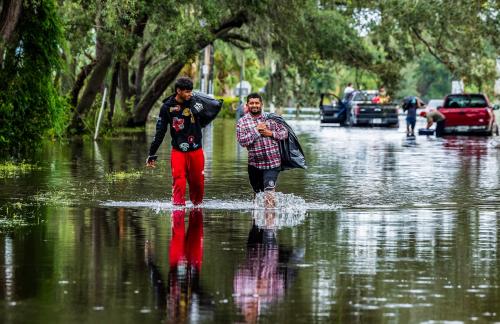DACA, the Deferred Action for Childhood Arrivals (DACA) program, is approaching its two-year anniversary and receiving increased attention as President Obama has indicated new executive actions on immigration are imminent. Both the existing program and any future program have similar goals: to use discretion and reduce focus on those who have been in the United States for some time and instead concentrate enforcement and resources on high priority cases.
New detailed estimates of the DACA-eligible population from the Migration Policy Institute illuminate several important distinguishing features of this hard-to-estimate population. Overall, they estimate that more than 2.1 million unauthorized youth could potentially benefit from DACA. Three subgroups are involved: 1.2 million who were immediately eligible when the program was announced two years ago; 426,000 who did not meet the education requirements then but could become or have become eligible; and 473,000 who will age into eligibility for the program once they turn 15 if they stay in school or receive high school equivalency. Especially valuable are their estimates of the DACA-eligible population for 25 states.
However, these estimates—although carefully calculated with thoughtful assumptions—should be treated (like all estimates) with a degree of uncertainty.
Yet these estimates carry weight and give service providers, advocates, community organizations, states, municipalities, and the federal government footing to gauge both the scale of and scope of the underlying population. Estimates are useful for service delivery planning, for communication and outreach, for fundraising and for considering appropriate assistance and approaches to those who may not yet meet the eligibility requirements, particularly the education component.
Also, as noted by the authors, these estimates do not attempt to account for those who may look like they meet the criteria based on the available data, but who are ineligible due to two major disqualifying factors: They have a criminal history, or they have not lived continuously in the United States. Thus, in all likelihood, these estimates represent the higher end of the range of those who are and may become eligible.
Those assisting the DACA-eligible population should bear that in mind as they encounter other motivational factors that may explain why eligibility doesn’t synch up with applications. From our research currently in the field, and the work of others, there are many who might be eligible or could become eligible who are not submitting applications. They face a number of barriers including: lack of funds for the $465 fee; perception they lack evidence to suitably support their case; insufficient knowledge about the program and their own eligibility; and isolation from networks that would encourage them to apply. This latter obstacle may be especially salient for those who need more education to qualify. In addition, older would-be eligible DACA applicants who do not currently meet the educational criteria may already be working and perceive little reason to invest the time and money to change their status.
Finally, there are those who would otherwise be eligible but have fears about the risks of the program and have made a decision not to apply.
Although DACA is not legal status, the reprieve from deportation, the right to work in the United States, and in some places other benefits such as in-state tuition and a driver’s license, are powerful incentives for youth to consider. The advantages are also important tools for shaping their future, the future of their communities and the larger U.S. society and economy.
The Brookings Institution is committed to quality, independence, and impact.
We are supported by a diverse array of funders. In line with our values and policies, each Brookings publication represents the sole views of its author(s).



Commentary
Limits to Estimating the DACA-Eligible Population
August 6, 2014